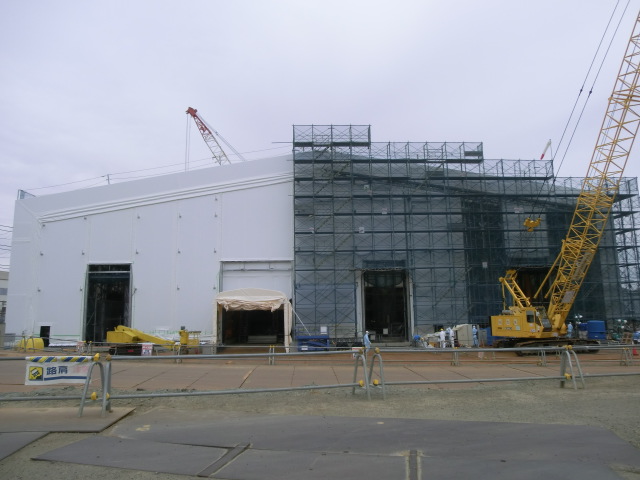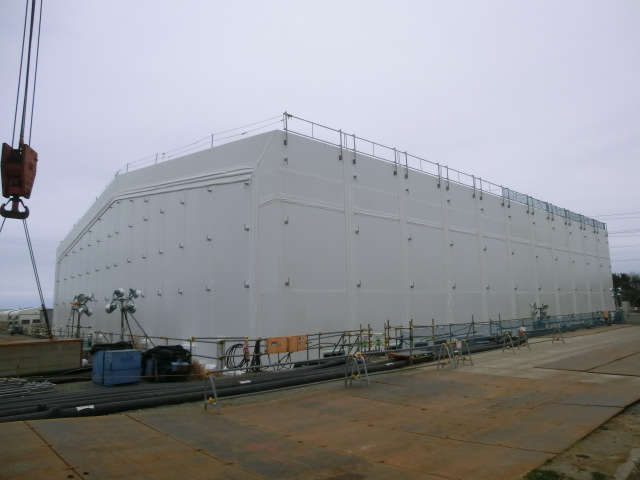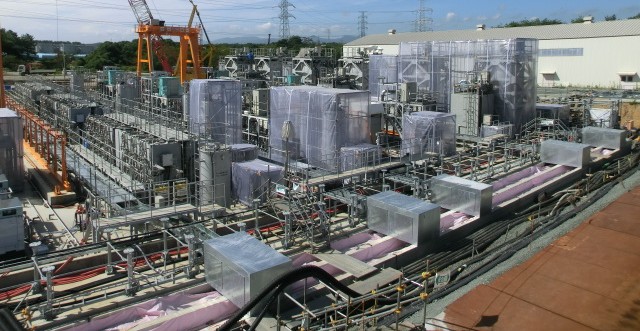A short announcement on March 30, 2013 from TEPCO:
本日(平成25年3月30日)午前9時56分、多核種除去設備(ALPS)において、水処理設備で処理した廃液を用いたホット試験を開始いたしました。
At 9:56AM today (March 30, 2013), we started the hot test of the multinuclide removal equipment (ALPS) using the water treated by the contaminated water treatment system.
多核種除去設備(ALPS)は3系統(A~C)ありますが、まずは1系統(A)でホット試験を行い、処理状況を確認してまいります。
The multinuclide removal equipment (ALPS) has three lines (A through C), but we are starting the hot test using the line A to observe the effectiveness of the treatment.
The vessels ("high-integrity containers") for the system managed to pass the test of being dropped onto concrete surface.
TEPCO's information on ALPS, released on March 29, 2013, "Overview of the Multi-nuclide Removal Equipment (ALPS) at Fukushima Daiichi Nuclear Power Station":
On hot testing:
- At hot testing, the capabilities of the multi-nuclide removal equipment to “remove radioactive materials” and to “maintain its capability to remove radioactive materials while in operation” are evaluated.
- In accordance with a direction given by NISA (at the time) “perform testing in a minimum amount of time/scope to evaluate the specified capabilities”, the hot testing will be performed on system A first.
[Evaluation of capability to remove radioactive materials]
- Confirm that the radioactivity densities of target 62 nuclides are below the density limit specified by the Reactor Regulation.
- Perform evaluation during the period in which approx. 1000-2000m3 of water is treated per system.
[Evaluation of capability to maintain its capability to remove radioactive materials while in operation]
- Confirm that the capability to remove radioactive materials is maintained until the timing of adsorbent replacement.
- Considering that the longest adsorbent replacement cycle (adsorbent 7) is 121 days (Flow rate of treated water: approx. 30,000m3), perform evaluation during the period in which approx. 30,000m3 of water is treated per system.
In the big scheme of things, ALPS is at the end of the treatment cycle:
Detailed schematics of ALPS:
This structure...
Is housing this (photo taken on September 16, 2012):
The hot testing of the line A is to continue till the end of July. The first analysis of treated water is scheduled in mid April, according to TEPCO's timeline (on page 8 of the handout above).
ALPS can remove 62 different nuclides, including strontium and americium. Pages 13 to 17 shows the nuclides and removal performance of ALPS (on a small-scale test, I suppose).
What's missing is tritium, which cannot be removed.
As space to build more temporary storage tanks becomes scarcer at Fukushima I Nuclear Power Plant, and some materials used to build these tanks (which are bolted together not welded) reach the end of useful life in 3 years, the company (and its effective owner, the national government) will try harder to win consensus on releasing the water treated by ALPS into the ocean.
Not before another politician, this time from LDP, does another performance of drinking the treated water to prove safety, I'm hoping.








 Tokyo Time
Tokyo Time
![[Most Recent Quotes from www.kitco.com]](http://www.kitconet.com/charts/metals/gold/t24_au_en_usoz_2.gif)


6 comments:
Reduction factor of more than ten billions for Strontium, for example?
This sounds way too good to be true, I fear.
Would it be too much to expect rational thinking here?
The radioactive fish in the harbor suggest that the site is leaking between 8 and 93 billion bequerels/day of Cs 137 into the ocean.
See:
http://www3.nhk.or.jp/news/genpatsu-fukushima/20130315/0600_osensui.html
or:
http://www.physicsforums.com/showthread.php?p=4327282#post4327282
Unless the stored water is pretty grossly contaminated, dumping it right now will be a negligible increment to the ongoing pollution from the site. It would make more sense to focus every effort on stopping the existing outflow, which should be pretty easy to achieve by freezing the ground.
The US was able to treat some of the most dangerous waste tanks at the Hanford site that way, before leakage from the tanks could pollute the Colombia River. Something similar is needed here, but it will take a long time based on the current plans for concrete walls and dams.
netudiant, unfortunately, yes, it would be too much to expect rational thinking, particularly in Japan.
Soil freezing? That's very interesting. So it's already done at Hanford?
netudiant,
I think you were not talking about a direct release of the about 400,000 cubic meters of SARRY "pre-purified" water.
We all know this water is still grossly contaminated with its inventory in a whopping magnitude of about 1.2 megacuries of Strontium-90.
And in comparison with this, the daily release of up to three curies of Caesium-137 (and probably Strontium, too) is just peanuts.
If ALPS works as advertised, and releases the water with all things (except tritium, ofc) at ND levels, there would be indeed no sensible reason (except maybe tritium decay) to keep the ALPS purified water stored.
But, honestly, there is another thing to keep in mind.
If they would construct concrete walls and dams to block tsunami and groundwater in- and outflow now, another question would arise:
Would it then be still possible to construct facilities to unload the four SFPs in the already very cramped area?
Maybe this is the reason why we see no efforts be taken building walls and dams, and at the same time see the pool unloading schedule accelerated by the Abe govt.?
@netudiant
The Hanford leaks haven't been frozen they are still leaking and everybody is talking about solutions to a problem that has NEVER been solved. Tank farm engineers didn't know wartime expediency would subject the single walled tanks to a hodge podge of various corrosive chemicals nor were the tanks designed to to last more than 20 years. (Extend and pretend is the nuclear motto the industry is happy to re-license old worn reactors like Fukushima that are past their designed lifespan and then blame them for being old if they fail)
http://www.tri-cityherald.com/2013/03/01/2294203/more-barriers-option-for-leaking.html
This article claims it will take years for the contamination to reach groundwater but that could be wrong. Hanford scientist claimed the leachant poured into cribs in area 100/300 would be ionically bound to the soil with negligible transport little did they know the pH of a leachant has a strong effect on inorganic contaminant transport.(for the laymen cribs are open trenches in permeable soil use to diffused liquid waste, about 440 billion gallons were poured into the ground at Hanford)
http://www.usatoday.com/story/news/nation/2013/02/22/6-hanford-tanks-leaking/1940213/
http://www.hanfordchallenge.org/the-big-issues/hanfords-reach/
Maybe you were referring to this failed attempt to stabilize the leaks?
"Leakage has been a problem in the past, with an estimated 1 million gallons of radioactive liquid having already leaked, but the tanks were believed to have been stabilized in 2005".
http://www.huffingtonpost.com/2013/02/27/washington-governor-hanford-reservation_n_2776825.html
@netudiant
The Hanford leaks haven't been frozen they are still leaking and everybody is talking about solutions to a problem that has NEVER been solved. Tank farm engineers didn't know wartime expediency would subject the single walled tanks to a hodge podge of various corrosive chemicals nor were the tanks designed to to last more than 20 years. (Extend and pretend is the nuclear motto the industry is happy to re-license old worn reactors like Fukushima that are past their designed lifespan and then blame them for being old if they fail)
http://www.tri-cityherald.com/2013/03/01/2294203/more-barriers-option-for-leaking.html
This article claims it will take years for the contamination to reach groundwater but that could be wrong. Hanford scientist claimed the leachant poured into cribs in area 100/300 would be ionically bound to the soil with negligible transport little did they know the pH of a leachant has a strong effect on inorganic contaminant transport.(for the laymen cribs are open trenches in permeable soil use to diffused liquid waste, about 440 billion gallons were poured into the ground at Hanford)
http://www.usatoday.com/story/news/nation/2013/02/22/6-hanford-tanks-leaking/1940213/
http://www.hanfordchallenge.org/the-big-issues/hanfords-reach/
Maybe you were referring to this failed attempt to stabilize the leaks?
"Leakage has been a problem in the past, with an estimated 1 million gallons of radioactive liquid having already leaked, but the tanks were believed to have been stabilized in 2005".
http://www.huffingtonpost.com/2013/02/27/washington-governor-hanford-reservation_n_2776825.html
Post a Comment